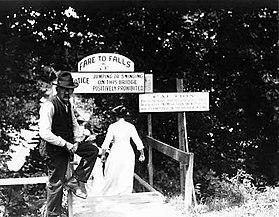Great Falls Park
| Great Falls Park | |
|---|---|
IUCN category V (protected landscape/seascape) | |
 | |
| Location | Fairfax County, Virginia, USA |
| Nearest city | McLean, Virginia |
| Coordinates | 38°59′51″N 77°15′18″W / 38.99750°N 77.25500°W |
| Area | 800 acres (320 ha) |
| Established | 1966 |
| Visitors | 645,000[citation needed] (in 2002) |
| Governing body | National Park Service |
| Great Falls (climbing area) | |
|---|---|
National Park Service | |
| Camping | none |
| Classic climbs |
|
Great Falls Park is a small
History
The Patowmack Canal, which George Washington partially funded, was a one-mile (1.6 km) bypass canal that began operating in 1785 to give small barges the opportunity to skirt around the falls and to distribute manufactured goods upstream and raw materials downstream. The park visitor center has the bottom portions of two wooden canal lock gates excavated in the 1980s from the canal. The gates survived from at least the 1830s and were found during restoration projects on stonework which were erected for the canal locks. Stonemason marks found on the stones are unique to each artisan and are identical to some found in foundation stones of the
During the construction of the canal,
Between 1906 and 1932, the
In January 1953, the Park was bought from the receivership by the Fairfax Park Authority using funds set aside to purchase right-of-way for the George Washington Memorial Parkway.[3] The George Washington Memorial Parkway was developed to ensure the easy linkage of George Washington's most visited places. Great Falls Park was a part of the Northern Virginia Parks system until it was transferred to the NPS in 1966. A proposed bridge to span the falls was also considered but, due to a strong lobby to eliminate additional bridges over the Potomac and concerns over environmental impacts, the project was never undertaken.
The park continues to provide picnic grounds and a visitor center but the carousel that operated between 1954 and 1972 was destroyed by a flood caused by Hurricane Agnes.
Access and amenities
Direct access to the park is usually by way of
The park has several viewing platforms that provide visitors with vantage points overlooking the falls. The NPS operates a visitor center near the falls.
Fifteen miles (24 km) of hiking trails traverse the park and follow a small stream known as Difficult Run. A scenic trail near the river travels upstream from a landing at the mouth of Difficult Run, climbs to the top of Mather Gorge and passes the falls, a dam, and a reservoir before ending in Fairfax County's Riverbend Park.
Rock climbers frequent the cliffs in Mather Gorge above the Potomac.
The park contains a large picnic area and sufficient parking for 600 vehicles. On busy weekends, all the parking may fill up by early in the morning, creating delays and temporary closures lasting up to several hours. The NPS does not permit camping in the park.
The falls total 76 feet (20 m) over a series of major cascades. The Great Falls are rated Class 5-6 Whitewater according to the International Scale of River Difficulty. The first kayaker to run them was Tom McEwan in 1975,[4] but only since the early 1990s have the Falls been a popular destination for expert whitewater boaters in the DC area. Below the falls, through Mather Gorge, the river is rated class 2-3 and has been a very popular kayaking run since the 1960s.
Entry into the water above the falls from the Virginia side is illegal. An average of seven drownings per year occur in the Potomac River in the park vicinity, most of them alcohol-related even though consumption of alcoholic beverages is illegal within the park.[citation needed]
|
See also
- Chesapeake and Ohio Canal National Historical Park, on the Maryland side of Great Falls
References
- ^ "Great Falls Timeline". National Park Service. Retrieved March 7, 2020.
- ISBN 9780817355098.
- ^ "Great Falls Park Goes to Fairfax County". The Arlington Sun. 16 January 1953. Retrieved 18 July 2023.
- ^ Pioneer Award Candidates 2007 of the International Whitewater Hall of Fame & Museum Archived 2008-11-21 at the Wayback Machine (retrieved on 16 September 2008)
External links
- "Great Falls". National Park Service. Retrieved 2010-09-02.
- "Great Falls Park Map". National Park Service. Retrieved 2010-09-02.
- Maps and aerial photos
- "Great Falls Park, USGS Vienna (VA, MD) Topo Map". TopoQuest. Retrieved 2008-06-29.








